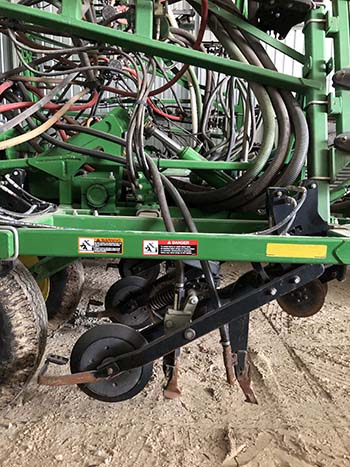Snapshot
Grower: Gary Virgin
Location: Bordertown, SA
Farm size: 2300 hectares
Enterprise: Cropping and sheep
Growing season rainfall: 480 millimetres
Soil types: loam to heavy soils
2020 cropping program: 2000ha wheat, beans and canola, 300ha livestock (approx 1000 ewes)
Seeding equipment: 12.2 metre (40 foot) 1870 John Deere on 30 centimetres (12-inch) spacing with knife point press wheels and 12,000 litre Simplicity tow between with three sealed bins.
A successful crop establishment of 600 tillers per square metre is where Gary Virgin would like to start his season off. Under favourable conditions this could possibly result in an eight tonne per hectare crop and in less favourable conditions around the 6–7 t/ha.
“If the plants and tillers aren’t there it’s impossible to get yield,” Gary says.
Gary’s tyne seeder bar is an 1870 John Deere with 30cm (12 inch) spacing and 40 rows. His knife points rip to 7.62cm (three inches)deep and sows at 8 kilometres per hour. He uses pre-emergent herbicide Sakura at 118 on wheat and Trifluralin in front of canola.

Gary’s 1870 John Deere with 30cm (12 inch) spacing and 40 rows with 12,000 litre Simplicity tow between with three sealed bins. Image: Megan Skeer
Nine years ago, Gary purchased the seeder bar for crop establishment purposes and accurate seeding and says it penetrates into the ground well. Gary is awaiting the arrival of his brand new 1870 John Deere.
“It’s the third one in a row, I still don’t know of any better!” he says.
Gary gets an accurate seed depth and the seed is covered every time. The only limitations he finds is the trash flow, which he has improved but not perfected, by adding coulters.
Gary’s air-cart is a 12,000 litre Simplicity tow between with three sealed bins. It has a roller metering system utilising both fine seeds and coarse seeds.
Gary has a double chute set-up with three primary lines followed by six secondary dividers with 32mm terminal lines. He has an E5 Simplicity in-cab monitor and the row-to-row accuracy for low seed/high seed rates is very good.
Key strategies

Gary’s key strategies to reliably achieve good crop establishment are knife points and press wheels. His knife points rip to 7.62cm (three inches) deep and sows at 8km/hr. Image: Megan Skeer
Gary’s key strategies to reliably achieve good crop establishment are knife points and press wheels. His soils are also improving with minimum-till, so seed soil contact is getting better and better.
“I don’t have trouble with trash flows and the system just seems to work,” Gary says.
To help with early establishment for maximising crop yield, Gary retains good seed, keeps up with new varieties and teams them with 70kg of MAP blend and deep banded urea. He aims for good early ground cover, which will help to choke out the weeds by blocking the sunlight.
To calculate the sowing rate and germination, Gary uses data from the previous year’s bean crop establishment and adjusts accordingly.
“Wheat rates don’t vary much from season to season,” he says the sowing depth is very shallow with the exception of beans, which he sows at 30mm deep. During sowing, Gary continually monitors and checks for blockages (every 10 to 15 hectares) and if everything is going well, the calibration is checked every one to two days.
Phosphorus is placed at seed depth and urea is placed 5.1cm (two inches) below the seed for canola and wheat, however no nitrogen is used with beans. Gary adjusts press wheel pressure if it’s too damp and reduces the pressure of the press wheels on soils that have been delved so the seed isn’t pushed in too deep.
Gary might increase the pressure a bit for cloddy soil and dry seeding for the best seed soil contact and depth.
Minimal paddock preparation required
Gary direct sows, so very minimal paddock preparation is required. He achieves this by cutting low with the harvester and spreading the straw evenly, a process which he finally got right with the most recent header he purchased.
Gary avoids grazing livestock on cropping paddocks, he rarely burns stubble and he may roll some paddocks for snail control.
Seed damage minimal
Seed damage is minimal as Gary sows beans from two boxes. He monitors the seed depth every couple of hours and adjustment is not often needed. There is no limit in time taken to fine tune the seeding depth though.
“Whatever it takes to get it right,” Gary says.
Gary has a very strict rotation of wheat, beans and canola, which helps reduce diseases.
Ten years ago wheat was always the safety crop but these days, as long as it rains, the gross margins are very similar on all crops. Gary believes good management practices with canola and beans makes them equal to wheat.
Improving soil health
To improve soil health. Gary rips below the seed with knife points. He is also moving away from conventional seeding systems with shearer field spans, harrows and shearer combines and breaking that hard pan, which allows for the development of a good healthy root system.
Challenges
The greatest challenges Gary faces are dealing with stubble, mastering interrow seeding and the seasons when he doesn’t get an opening break. Gary will start sowing on Anzac Day regardless of moisture with beans, followed by canola around May 1 or earlier if there has been rain.
Top tips
Gary's top tips to improve crop establishment include:
- Soil health
- Good air-seeder
- Seed placement
- Paddock rotation
- Weed control.
More information: BCG, 03 5495 2787.

























































